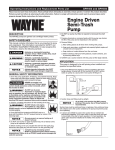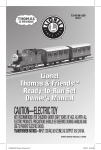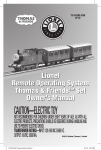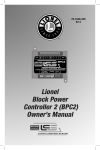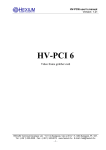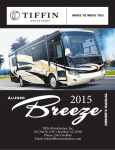Download Lionel Trains 71-8340-250 Building Set User Manual
Transcript
71-8340-250 8/04 Lionel Train Master Locomotive Set Owner’s Manual featuring and SYSTEM Congratulations! ongratulations on your purchase of the Lionel Train Master diesel locomotive set! This set consists of two powered locomotives. On the outside, these locomotives feature numerous prototypical details and expert decoration. Inside the bodies, each locomotive is equipped with TrainMaster Command Control and the RailSounds sound system. This set is ready for duty on your layout. C Features of each locomotive • TrainMaster Command Control equipped—able to run in the TrainMaster Command Control environment or in the conventional environment with only a standard transformer • RailSounds sound system with CrewTalk communication and TowerCom announcements • Odyssey System for speed control • Magne-Traction track gripping system • Directional lighting including operating LED headlights • Operating marker lights • ElectroCouplers • Dual powerful maintenance-free motors with momentum flywheels • Four traction tires • Fan-driven smoke units • Realistic, pulsing Mars lights • Operating radiator fans • Lighted number boards • Lighted cab interior • Minimum curve: O-31 The following Lionel marks may be used throughout this instruction manual and are protected under law. All rights reserved. Lionel®, TrainMaster®, Odyssey®, RailSounds®, CrewTalk™, TowerCom™, DynaChuff™, StationSounds™, Pullmor®, ElectroCoupler™, Magne-Traction®, CAB-1® Remote Controller, PowerMaster®, Lionel ZW®, ZW®, PowerHouse®, TMCC®, Lionelville™, Lockon®, Wireless Tether™ The name FasTrack® is used with permission from Pitsco, Inc. 2 Table of contents Quick Start Transformer operations TrainMaster Command Control operations 4 4 Conventional transformer operations Conventional operations Operating your locomotive set in the conventional environment Locking your powered locomotive into a single direction Coupling your locomotive in the conventional environment 5 6 7 8 RailSounds sound system operations RailSounds sound system operations Installing the battery Using the RailSounds sound system in the conventional environment Installing a Lionel Sound Activation Button for conventional operation Using the RailSounds sound system in the TrainMaster Command Control environment 9 10 11 12 13 Odyssey System operations Odyssey System operations Activating the Odyssey System in the conventional environment Turning off the Odyssey System in the conventional environment Odyssey System Command Control operation 14 14 15 16 TrainMaster Command Control operations TrainMaster Command Control operations Operating your locomotive set in the Command Control environment CAB-1 Remote Controller commands CAB-1 Remote Controller numeric keypad commands Tuning your locomotive’s performance Assigning new ID#’s to your locomotives Building a lash-up Reprogramming your locomotives to restore features Maintaining and servicing your locomotive Adding fluid to your locomotives’ smoke generators Lubricating your locomotive set Replacing your locomotive set’s LEDs and lamps Replacing the traction tires Limited Warranty/Lionel Service 3 17 17 18 19 20-21 22 23 24 25 26 27 27 28 Quick Start Transformer operations 1. Slide the Odyssey System switch to the NO ODY position to operate without speed control. To operate your locomotive with speed control, slide the Odyssey System switch to the ODY position and refer to pages 15 and 16. 2. Place your locomotive on Lionel or Lionel-compatible O-31 or larger track. 3. Power your locomotive at 8-18 volts with your alternating current (AC) transformer. Note! Do not power your locomotive with a direct-current (DC) transformer. Damage to sensitive electronic components may occur. 4. Wait three to eight seconds as your locomotive determines whether it is in a conventional environment or a TrainMaster Command Control environment. 5. Move ‘em out! Press the DIRECTION button on your controller, then throttle up. TrainMaster Command Control operations o operate your locomotive in the Command Control environment, you need a Command Base (available separately, 6-12911) and a CAB-1 Remote Controller (available separately, 6-12868). 1. Turn off track power and plug-in the Command Base. 2. Place your locomotive on Lionel or Lionel-compatible O-31 or larger track. 3. Increase track voltage to full power (19 volts AC). T Note! Do not power your locomotive with a direct-current (DC) transformer. Damage to sensitive electronic components may occur. 4. Press ENG and 1 to address your locomotive with your CAB-1 Remote Controller. 5. Throttle up and move ‘em out. 4 Conventional transformer operations Conventional operations our locomotive set is capable of operating in the conventional environment with nothing more than a standard Lionel alternating-current (AC) transformer. In the conventional environment, your locomotives cycle through a repeating pattern of operations: forward, neutral, reverse, neutral, and so on. To advance to the next operation, press the DIRECTION button on your transformer. Alternately, you could use the throttle to briefly turn off track power so that the locomotives advance to the next operation when power is restored. Once you cycle the locomotives into forward or reverse, you control your locomotive set’s speed by varying track voltage with the transformer’s throttle. To increase the speed of the locomotive, you increase track voltage. To decrease the speed, you decrease track voltage. To stop the locomotive and to change directions (or to enter neutral), track voltage is turned off or interrupted. Use the HORN and BELL buttons on your transformer (or separate buttons if your transformer is not equipped with these controls) to activate these features. To experience all of your locomotive set’s features, we recommend operating in the TrainMaster Command Control environment. With a simple one-wire connection, you can use the CAB-1 Remote Controller to access all of the functions of your locomotive set. Refer to pages 17 to 24 to see how to operate your locomotive set in the TrainMaster Command Control environment. Y 5 Conventional transformer operations Operating your locomotive set in the conventional environment 1. Slide the Odyssey System switch to the NO ODY position to operate without speed control. To operate your locomotive with speed control, slide the Odyssey System switch to the ON position and refer to pages 14 and 15. Note! Keep the Odyssey System switch in the NO ODY position when you are not running your locomotive with speed control. If the Odyssey System switch remains in the ODY position, your locomotive may lock into an unwanted speed setting as you adjust your throttle to control train speed. This effect may be caused by variations in your power supply and/or conditions on your layout. To operate your locomotive with the Odyssey System for speed control, slide the Odyssey System switch to the ODY position and refer to the procedures on pages 14 and 15. Be sure that the locomotive is not in motion and track power is turned off when you engage the Odyssey System switch. 2. Place your locomotive set on Lionel or Lionel-compatible O-31 or larger track. Be sure that the unit numbered TM-2 faces the rear of the train. 3. Power your locomotive set at 8-18 volts with your alternating current (AC) transformer. Caution! Power your locomotive set with an alternating-current (AC) transformer only. Powering your locomotive set with a direct-current (DC) transformer may result in damage to sensitive electronic components. 4. Wait three to eight seconds as your locomotive set determines whether it is in a conventional environment or a TrainMaster Command Control environment. When the locomotive set has determined that a TrainMaster Command Base is not connected to the track, the locomotive set’s headlight will illuminate and the RailSounds sound system will start. You are ready for operation in the conventional environment. 5. Move ‘em out! Press the DIRECTION button on your transformer to sequence your locomotives through the repeating pattern of operations: forward, neutral, reverse, neutral, and so on. You may also briefly turn off track power to advance the locomotive set to the next operating state. Adjust the throttle until your locomotive set moves at your desired speed. You will find that the radiator fans rotate when the locomotive is in forward or reverse. The fans are off when the locomotive is in neutral. Note! When placing your locomotives on your layout for the first time, they will start out in neutral. Thereafter, they will start in forward after every power interruption lasting five seconds or longer. Use the HORN and BELL buttons on your transformer to activate those features. Refer to page 12 if your transformer is not equipped with those buttons. 6 Conventional transformer operations Locking your powered locomotives into a single direction hen the Command reverse unit switch is in the RUN position, your locomotives sequence through a repeating pattern of operations: forward, neutral, reverse, neutral, and so on. To “lock” your locomotives into a single direction (for example, to operate in forward only), you can deactivate the Command reverse units’ sequencing function. Refer to Figure 1 for the location of the Command reverse unit switch on each unit. W Note! If you will be running the locomotives together, perform this procedure on both units simultaneously. 1. Use your transformer’s DIRECTION button or interruptions in track power to get your locomotive moving in the desired direction or into neutral. 2. Slow the locomotive down without stopping (reduce the throttle without turning off track power). 3. Slide the Command reverse unit switch to the PGM position. At this point, the locomotive is “locked” into your chosen direction. To restore the forward-neutral-reverse sequence, just slide the Command reverse unit switches back to the RUN position. Note! Your locomotives will “reset” to forward after any power interruption lasting five seconds or longer, regardless of the direction you set. RailSounds sound system switch (see pages 9-13 for details) SND NO SND ODY PGM SMK NO ODY Odyssey system switch (see pages 14-16 for details) FRONT RUN NO SMK Smoke unit switch (see page 25 for details) Command reverse unit switch Figure 1. Switch locations 7 Conventional transformer operations Coupling your locomotives in the conventional environment ach locomotive unit is equipped with two ElectroCouplers that are released by remote control at any point around your layout in the TrainMaster Command Control environment. In the conventional environment, the ElectroCouplers will not open manually or by using a Remote-Control Track section. To couple your locomotive in the conventional environment, you must rely on a piece of rolling stock equipped with a magnetic coupler. Simply release the magnetic coupler and couple the rolling stock to the locomotive, even if the ElectroCoupler is closed. Keep in mind that you may still make use of Lionel Remote-Control Track sections (6-65530 for O gauge; 6-12746 and 6-65149 for O-27 gauge; and 6-12020 for FasTrack layouts) with the magnetic couplers on the rolling stock. Place the trigger disc on the magnetic coupler over the central coil on the Remote-Control Track section, then press UNCOUPLE on the track section’s controller. As illustrated in Figure 2, the magnetic field pulls the disc downward, releasing the coupler. E Remote-Control Track Section Figure 2. Magnetic coupler operation 8 RailSounds sound system operations RailSounds sound system operations our locomotives are equipped with the Lionel RailSounds sound system, the most realistic model railroad sound system in the world. The RailSounds sound system brings the sounds of the railroad to your layout through high quality digital samples of real locomotives. When you operate your locomotives in the conventional environment, you get the realistic sounds of the diesel engines, which automatically rev up as the speed of the locomotives increase. You can sound the locomotive set’s horn or activate the ringing of the mechanical bell. When you are through with operations and power down the track, your locomotive set’s RailSounds sound system starts a realistic diesel shutdown sequence (a nine-volt alkaline battery is required for the shutdown sequence). When you operate your locomotives in the TrainMaster Command Control environment, you get full control of the RailSounds sound system. You still get the horn and bell sounds. The locomotive’s RPM sounds automatically rev up, but you can also set a particular RPM sound using your CAB-1 Remote Controller. In the Command Control environment, the release of the ElectroCouplers is accompanied by a coupler release sound. Use the BRAKE button, and listen for the sound of squealing metal. You can also trigger CrewTalk communication and TowerCom announcements, which simulate the interaction between the locomotive crew and the yardmaster. Whenever you choose to shutdown your locomotive, the realistic shutdown sequence commences (a nine-volt alkaline battery is required for the shutdown sequence). Y 9 RailSounds sound system operations Installing the battery hile the RailSounds sound system is powered through the track, we recommend that you install a nine-volt alkaline battery in each locomotive to prevent the sound system from shutting down during track power interruptions (for example, at a switch or a dirty section of track). Follow these steps and refer to Figure 3 as you install the battery. W Note! If the RailSounds sound system turns off during interruptions in track power, you may need to replace the battery. 1. Carefully lift up and remove the roof-top hatch as illustrated in Figure 3. 2. Remove the protective cover from the battery harness. 3. Snap the battery harness onto the nine-volt alkaline battery’s terminals. 4. Slide the battery into the battery clip. 5. Replace the hatch. Battery harness Battery holder Volume control knob Figure 3. Battery installation (powered A-unit locomotive only) 10 RailSounds sound system operations Using the RailSounds sound system in the conventional environment hen you first begin to operate your locomotives, you will hear the sounds of the locomotive set at rest. As the locomotive set moves, the RPM sounds automatically increase with the locomotives’ speed. In the conventional environment, the horn and bell sounds are activated by your transformer controls. To silence the diesel roar, slide the RailSounds sound system switch located on the underside of the locomotives (refer to Figure 1 on page 7) to the NO SND position before you power up the locomotive set or after the locomotive set has been powered down for a minimum of ten seconds. The horn and bell sounds will still be active. To adjust the volume, use the volume control knob located beneath the roof-top hatch. W Note! For proper operation of the RailSounds sound system during track power interruptions and for the locomotive set shutdown sequence, you must install a ninevolt alkaline battery in both locomotives. See page 10. In the conventional environment, you will experience several features of the RailSounds sound system. • Four levels of diesel roar. Your locomotive's speed automatically determines the level of diesel RPM roar. • MultiHorn. A different horn sound at different speeds—a RailSounds sound system exclusive. • Mechanical bell. Press BELL on your transformer to begin the effect, then press BELL a second time to discontinue the effect. • Reverse unit reset sound. Power down your track, wait three seconds, and listen for the air-release sound—that’s the locomotive set telling you that its Lionel Command reverse unit has reset to forward. • Shutdown sequence. When you turn off track power, you have two seconds to power up again after you hear the reverse unit reset sound. If you do not restore power, you will hear the realistic diesel shutdown sequence. Because track power is off, a battery is required for this sequence to function. 11 RailSounds sound system operations Installing a Lionel Sound Activation Button for conventional operation f your transformer lacks HORN and BELL buttons, you will need to install Lionel no. 610-5906-001 Sound Activation Buttons (available separately) to activate the locomotive’s horn and bell sounds. Connect the buttons as shown below. Be sure that all track power passes through the Sound Activation Button(s). Do not bypass the buttons. I For AC transformers lacking a bell button 1 2 Common/Ground/U Black wire Existing wire POWER SUPPLY Red wire Power/A Lionel no. 610-5906-001 Sound Activation Button for activating the bell For AC transformers lacking bell and horn/whistle buttons Common/Ground/U Red wire Existing wire Red wire Black wire Wire nut Lionel no. 610-5906-001 Sound Activation Button for activating the horn POWER SUPPLY Power/A Lionel no. 610-5906-001 Sound Activation Button for activating the bell 12 RailSounds sound system operations Using the RailSounds sound system in the TrainMaster Command Control environment o access all of the features of the RailSounds sound system, you must operate your locomotives in the TrainMaster Command Control environment. The CAB-1 Remote Controller is required to activate features such as TowerCom announcements, CrewTalk communication, and coupler release sounds. Refer to pages 16 to 20 to learn how the RailSounds sound system is integrated into TrainMaster Command Control operations. T Note! For proper operation of the RailSounds sound system during track power interruptions and for the locomotive shutdown sequence, you must install a nine-volt alkaline battery. See page 10. In the TrainMaster Command Control environment, you will experience all of the features of the RailSounds sound system. • Four levels of diesel roar. Your locomotive’s speed automatically determines the level of diesel RPM roar. You may also set the RPM sounds to a particular level using your CAB-1 Remote Controller. • MultiHorn. A different horn sound at different speeds—a RailSounds sound system exclusive. • Mechanical bell Press BELL on your CAB-1 Remote Controller to begin the effect, then press BELL a second time to discontinue the effect. • Squealing brakes. Press the BRAKE button and listen for the squealing of the locomotive’s brakes. • Coupler release sounds. Use your CAB-1 Remote Controller to release an ElectroCoupler, and you get the sounds of the coupler opening. • TowerCom announcements. These messages simulate the communication from the yardmaster. You get “clear for departure” and “hold for clearance” messages. • CrewTalk communication. Listen for the crackling, unintelligible radio communication inside your locomotive. • Reverse unit reset sound. Power down your track, wait three seconds, and listen for the air-release sound—that’s the locomotive telling you that its Lionel Command reverse unit has reset to forward. • Shutdown sequence. When you turn off track power, you have two seconds to power up again after you hear the reverse unit reset sound. If you do not restore power, you will hear the realistic diesel shutdown sequence. Because track power is off, a battery is required for this sequence to function. 13 Odyssey System operations Odyssey System operations he Odyssey System is “cruise control” for your locomotives. Once the speed control is set, your locomotive set will maintain a constant speed, no matter what load is placed on the locomotive set or what grades you have on your layout. The Odyssey System also allows for extremely slow movement that will amaze any scale enthusiasts. In the conventional environment, you activate the Odyssey System and set your locomotives to operate at one particular speed. Your locomotives maintain this speed until you turn off speed control or set a new speed. In the Command Control environment, the Odyssey System is activated using your CAB-1 Remote Controller. When the Odyssey System is active, your locomotives will maintain this speed until you adjust the CAB-1 Remote Controller’s throttle. T Note! In the conventional environment, keep the Odyssey System switch in the NO ODY position when you are not running your locomotive with speed control. If the Odyssey System switch remains in the ODY position, your locomotive may lock into an unwanted speed setting as you adjust your throttle to control train speed. This effect may be caused by variations in your power supply and/or conditions on your layout. Activating the Odyssey System in the conventional environment F ollow these steps to activate your locomotives’ speed control in the conventional environment. Note! Perform these steps on both units at the same time if you will be running them together. 1. Slide the Odyssey switches to the ODY position. Refer to Figure 1 on page 7 for the location of the switch. 2. Run the locomotive set at the desired speed for approximately five seconds. 3. Press and hold the HORN button on the transformer. 4. While holding the HORN button, increase the track voltage by at least three volts (at least a quarter turn). The locomotives’ speed will increase before returning to the initial speed. At this point, speed control is set. Increasing the throttle will not increase the speed of the locomotive; however, decreasing the throttle will decrease the speed of the locomotive. Note! You may notice a slight delay between adjusting your transformer’s throttle and the change in your locomotives’ speed as the Odyssey System works to regulate the voltage to the motor. If you desire instantaneous response to throttle changes, turn off the Odyssey System. Caution! In the conventional environment, the lights in the locomotive are connected directly to track power. To prolong the life of your lamps, do not exceed 14 to 16 volts for extended periods. 14 Odyssey System operations Turning off the Odyssey System in the conventional environment F ollow these steps to turn off the Odyssey System in the conventional environment. 1. While the locomotives are in neutral, turn your controller up to the maximum power (no more than 19 volts), wait one second, then press and hold the horn button. 2. While holding the HORN button, slowly reduce the track voltage to approximately one-third or one-half of the full power. 3. Release the HORN button. 4. Move the locomotive set in forward OR reverse. The locomotive set is now out of speed control mode. Note! Sliding the Odyssey System switch to the NO ODY position will disable the Odyssey System. We recommend that you keep the Odyssey System switch in the NO ODY position unless you want to activate the locomotive’s speed control. 15 Odyssey System operations Odyssey System Command Control operation hen the Odyssey System is activated, changes in the speed of the locomotives will correspond to each signal from the Command Base. For example, when you address the locomotive and slowly turn the throttle knob, the first flash of the light on the Command Base corresponds to the first speed step, which is the slowest speed of the locomotive. The locomotive will maintain that speed until you increase or decrease the throttle. In the TrainMaster Command Control environment, you can use your CAB-1 Remote Controller to turn the Odyssey System on or off. The position of the Odyssey System switch (see Figure 1 on page 7) is the Odyssey System default setting when you power up the locomotives. You can override the default setting with the following commands. The override settings will be cleared and the default setting will be restored when you power down the locomotive. Do not wait longer than two or three seconds between pushing the buttons in each sequence. If the command is not accepted, repeat the sequence. W Note! The locomotives must be in “neutral” when you enable or disable the Odyssey System. Turn off the Odyssey System. Note! When you press 7, you will trigger a TowerCom announcement. This has no impact on the Odyssey System function. Turn on the Odyssey System. Note! When you press 9, you will activate the Air release sound and turn on the smoke unit (if it was off). This has no impact on the Odyssey System. 16 TrainMaster Command Control operations TrainMaster Command Control operations rainMaster Command Control is the advanced model railroad control system from Lionel. To operate your locomotive set in the Command Control environment, you need a Command Base (available separately, 6-12911) and a CAB-1 Remote Controller (available separately, 6-12868). Your commands are sent by the CAB-1 Remote Controller to the Command Base, which then translates the command into digital code. That code is sent through the outside rails to your locomotive, which will not respond until it recognizes its unique ID#. TrainMaster Command Control gives you the power to operate multiple Command-equipped locomotives on the same track at the same time. Keep in mind that track power is like gasoline in the tank of a car—it gives you the power to go places, but it doesn’t tell you where to go or how fast to get there. T Operating your locomotive set in the Command Control environment 1. Turn off track power and plug-in the Command Base. Be sure that the Command Base is connected to the outside rail or to the Common/Ground/U terminal on your track power supply. 2. Place your locomotive set on Lionel or Lionel-compatible O-31 or larger track. Be sure that the locomotive numbered TM-2 faces the rear of the train. 3. Increase track voltage to full power (no more than 19 volts AC). On PowerMasters, slide the CMD/CONV switch to CMD. Program Track Power Controllers to Command Control operation. 4. To operate your locomotive as a lash-up, press TR and 9 on your CAB-1 Remote Controller. To operate your locomotives individually, press ENG and enter 1 for the locomotive numbered TM-1 or 2 for the locomotive numbered TM-2. Note! To change the lash-up or individual ID#’s, refer to pages 22 and 23. 5. Throttle up and move ‘em out! Your locomotive set will respond to every command from your CAB-1 Remote Controller. 17 TrainMaster Command Control operations CAB-1 Remote Controller commands T he CAB-1 Remote Controller commands are detailed below. The corresponding RailSounds sound system effects are in bold italic type. Releases the front coupler. Coupler release sound. Releases the rear coupler. Coupler release sound. Activates the numeric keypad. Air release sound. Toggles the headlight on and off. Accelerates the locomotive set with a clockwise rotation. Decelerates the locomotive set with a counter-clockwise rotation. Shuts down all PowerMasters on your railroad. Stops all TrainMaster Command Control-equipped locomotive sets in operation. Use HALT only in emergency situations. Activates the locomotive set’s horn. Release the button to discontinue the sound. Multihorn diesel horn sound. Toggles the bell sound on and off. Mechanical bell sound. Changes the locomotive set’s direction. The locomotive set decelerates to a stop and continues in the opposite direction when you increase the throttle. Air release sound. SET L M H Increases the locomotive set’s speed while the button is pressed. Release the button to return to the initial speed. Decreases the locomotive set’s speed while the button is pressed. Squealing brake sounds. 18 TrainMaster Command Control operations CAB-1 Remote Controller numeric keypad commands hen you press the AUX1 button on your CAB-1 Remote Controller, you turn the numeric AUX1 keypad into ten command buttons. These commands are specific to your locomotive set, and an overlay is included to help you learn these functions. After you press the AUX1 button, you will be able to press any numbered button until you address a different Command Control equipped product. The corresponding RailSounds sound system effects are in bold italic type. ➠ ➠ W ➠ ➠ Stops and resets the locomotive set. Resets the locomotive set’s direction to forward. Resets the RailSounds sound system to automatic RPM operation. Horn blows. RPM sounds return to automatic. Raises the volume of the RailSounds sound system. Sound volume increases. Activates CrewTalk communication, unintelligible radio dialogue. CrewTalk communication. Increases the RailSounds sound system RPM level. Starts the RailSounds sound system. RPM level increases. Start-up sequence commences. Lowers the volume of the RailSounds sound system. Sound volume decreases. Activates the shutdown sequence. Like prototypical locomotive sets, the RPM level must be at idle for shutdown to occur. Press 6 repeatedly to lower the RPM level until the RPM sounds reach idle. Press 5 to initiate the shutdown sequence and listen for the CrewTalk communication. Keep in mind that the horn, bell, and RPM sounds are inactive until you restart the RailSounds sound system by pressing 3. CrewTalk communication. Diesel shutdown sequence. Lowers the RailSounds sound system RPM level. RPM level decreases. Activates a TowerCom announcement, which includes a call-out specific to your locomotive set. Pressing AUX1, 7 triggers a “hold for clearance” message. Press 7 again, and a “clear for departure” message plays. There is a four-second delay in this function. TowerCom announcement. Turns off the smoke units and the radiator fans. Air release sound. Turns on the radiator fans. Also, turns on the smoke units if the smoke unit switches are in the ON position. Be sure to add smoke fluid before turning on the smoke units to prevent damage to your locomotives. Air release sound. Note! You may use the CAB-1 Remote Controller to turn on the smoke unit only if the locomotive set’s smoke unit switches are in the ON position. The smoke unit switch does not control the radiator fans. 19 TrainMaster Command Control operations Tuning your locomotive set’s performance T rainMaster Command Control allows you to fine-tune the performance of your locomotive set. Use your CAB-1 Remote Controller to make these adjustments. Note! These settings will be lost if you assign a new ID#. Momentum The TrainMaster Command Control momentum feature simulates the labored performance of a locomotive pulling a light, moderate, or heavy load. Press L, M, or H (located under the removable panel on the CAB-1 Remote Controller) to adjust the momentum setting. For quicker response to your commands, press L. Your locomotive set will keep this setting until it is changed. Adjusting the speed The BRAKE and BOOST buttons give you incremental control of your locomotive’s speed while you press and hold these buttons, allowing you to make small, gradual adjustments around curves and over grades. The locomotive set will resume its initial speed when the buttons are released. Listen for the squeal of your locomotives’ brakes when you use the BRAKE button. Sound quality Press AUX1, 1 or 4 on your CAB-1 Remote Controller to raise and lower the overall volume of the RailSounds sound system. To limit your locomotives’ volume, we recommend that you adjust your locomotives’ volume control knob (see Figure 3 on page 10 for the location). Setting the maximum speed You may use your CAB-1 Remote Controller to set your locomotives’ maximum speed. This will prevent the locomotive set from derailing as a result of excessive speed. Note! Perform this procedure on both units simultaneously if you will be running them together. 1. With both Command reverse unit switches in the RUN position, address your locomotive set by pressing TR and the lash-up ID#. 2. Press SET on the CAB-1 Remote Controller. The headlight will flash. 3. Get your locomotive set moving at your desired maximum speed. 4. Press BOOST. The maximum voltage has been set. To clear this setting, press SET and then BOOST, holding each button for one second. To set the maximum speed of an individual unit, address the locomotive using ENG and the unique locomotive ID#. 20 TrainMaster Command Control operations Tuning your locomotive set’s performance (continued) Setting the minimum speed You may use your CAB-1 Remote Controller to set your locomotive’s minimum, or stall, speed. Note! Perform this procedure on both units simultaneously if you will be running them together. 1. With both Command reverse unit switches in the RUN position, address your locomotive by pressing TR and the lash-up ID#. 2. Press SET on the CAB-1 Remote Controller. The headlight will flash. 3. Get your locomotive moving at your desired minimum speed. 4. Press SET again. The locomotive set will stop. The next time you throttle up, your locomotive set will start at the speed you set. To clear this setting, press SET twice, holding the button for one second each time. To set the maximum speed of an individual unit, address the locomotive using ENG and the unique locomotive ID#. 21 TrainMaster Command Control operations Assigning new ID#’s to your locomotives hile you may operate your locomotive set as a lash-up, you will want to give each unit a unique ID#. Each locomotive will respond to commands associated with its ID# while all other units will disregard these commands. This allows you to open the appropriate ElectroCouplers and set the directional lighting. W Note! To restore your locomotive set’s functions, see page 24. 1. Slide the Command reverse unit switch on your locomotive to the PGM position. See Figure 1 on page 7 for the locations of the Command reverse unit switch on each unit. Note! Work with only one locomotive at a time. 2. Place the locomotive set on the track. 3. Connect the Command Base and plug it in. 4. Power up the track. 5. Press ENG. 6. Enter the unique ID#. Choose any number from 1 to 99 that has not been assigned to another locomotive set (ENG). We recommend using a part of your locomotive’s cab number. 7. Press SET. The locomotive’s horn will sound or the lights will flash. 8. Slide the Command reverse unit switch back to the RUN position. The locomotive’s ID# has been set. Be sure to record the new ID# for your reference. Be sure to build a new lash-up using this ENG ID#. See page 23. 22 TrainMaster Command Control operations Building a lash-up rainMaster Command Control allows you to couple your Command Control-equipped locomotives together, forming a multiple unit lash-up. Just like with the real railroads, lash-ups allow you to pull longer trains and climb steeper grades. You will find that the lighting operates prototypically—the lead unit’s headlight and interior lights are illuminated when the train is in forward, and the rear unit’s headlight and interior lights are on when the train is in reverse. For more information, refer to your TrainMaster Command Control manual. To build a lash-up, assign a unique engine (ENG) ID# to each unit. Arrange the units on the track and couple them together. The Command reverse unit must be set to RUN/FORWARD. T Note! If you press a wrong button, start over with that particular unit. The assignment isn’t saved until you press SET. Start with the lead (front) unit 1. Press TR and enter your lash-up ID# (1-9) on your CAB-1 Remote Controller. No other lashup or track should share this ID#. 2. Enter the unique ID# of the lead unit. 3. Press F. 4. Press SET on the CAB-1 Remote Controller. Complete the lash-up by adding the rear unit 1. Press TR and enter the lash-up ID# (1-9) on your CAB-1 Remote Controller. 2. Enter the unique ID# of the rear unit. 3. Press R. 4. Press SET on the CAB-1 Remote Controller. You are now ready to operate your locomotive as a lash-up. Simply press TR and enter the lash-up ID#, then use your CAB-1 Remote Controller to operate your locomotives. To operate an individual unit within the lash-up, press ENG and enter the ID# for that particular unit. 23 TrainMaster Command Control operations Reprogramming your locomotives to restore features I f your locomotives are unresponsive to your commands in the TrainMaster Command Control environment, we recommend that you follow this procedure to reset your locomotive set. Note! Perform this procedure on only one unit at a time. Do not attempt to reprogram both units simultaneously. 1. Slide the Command reverse unit switch to the PGM position. See Figure 1 on page 7 for the locations of the Command reverse unit switches on each unit. 2. Plug in and connect your Command Base. 3. Place your locomotive on the track, then power up the track. 4. Press ENG and enter the locomotive’s ID#. 5. Press SET. 6. Press ENG and enter the locomotive’s ID# again. 7. Press AUX1. 8. Enter 8 for this particular locomotive. 8. Turn off track power and wait ten seconds. 10. Slide the Command reverse unit switch back to the RUN position. At this point, your locomotive has been reset. Restore power to the track and operate the locomotive as usual. Be sure to use the ID# entered in Step 4. 24 Maintaining and servicing your locomotive set Adding fluid to your locomotives’ smoke generators oth your locomotives are equipped with a smoke generator that produces a safe, clean, white smoke during operation. In order to function, the smoke generator requires the periodic addition of Lionel smoke fluid. A small bottle of smoke fluid is included with your locomotive set. To add smoke fluid, press down and unscrew the cap of the smoke fluid bottle. Pierce the tip of the nozzle with a pin, then add 10 to 15 drops of fluid into the stack of your locomotive as illustrated in Figure 4. Power up your locomotive, and smoke production will start momentarily. Smoke production will start faster if you operate your locomotive at higher speeds. Smoke production is greatest at high voltages and when the locomotive pulls a heavy load. When smoke production decreases, add four to eight additional drops of smoke fluid. If you prefer to operate your locomotives without smoke, locate the smoke unit switch on the underside of each locomotive and slide it to the NO SMK position. Refer to Figure 1 on page 7 for the location of this switch. When the smoke unit switch is in the ON position, always keep a small amount of smoke fluid in the smoke unit. Operating your locomotive’s smoke unit without smoke fluid will cause damage to the heating element. B Caution! Always operate your locomotive’s smoke unit with the addition of smoke fluid to prevent damage to the heating element. Rear Front Add smoke to either hole — not both Figure 4. Adding smoke fluid 25 Maintaining and servicing your locomotive set Lubricating your locomotive set elp your Lionel locomotive set lead a long and productive life on your railroad by maintaining it properly. To keep your locomotive set lubricated, we recommend that you purchase a Lionel Lubrication and Maintenance Kit (6-62927), available from your authorized Lionel dealer. When you find that the lubrication points illustrated in Figure 5 appear dry, lubricate your locomotive set after you have removed any accumulated dirt and dust. There are two basic rules to keep in mind when you are lubricating your locomotive set: use only a small amount of lubrication and avoid getting grease or oil on your locomotive set’s wheels, roller pick-ups, or the track. H FRONT Body screws Lubriucate with Lionel oil sparingly Lubriucate with Lionel grease sparingly Body screws Lubriucate with Lionel oil sparingly Lubriucate with Lionel grease sparingly Body screws Figure 5. Lubricating the locomotives REAR 26 Maintaining and servicing your locomotive set Replacing your locomotive set’s LEDs and lamps our locomotive set is illuminated by several LEDs and lamps. While the LEDs are expected to last for the life of the locomotive set, you may find that the lamps may require replacement. We recommend that you have the lamps serviced at an authorized Lionel Service Center. See the Lionel Service section on page 28 for more information. Y Replacing the traction tires ach locomotive is equipped with traction tires to increase the tractive effort of your locomotive set and allow it to pull more cars at once. During the course of normal operations, the traction tires may become worn out. We recommend that you have the traction tires replaced by an authorized Lionel Service Center because the truck and side frames must be removed to access the wheels. See the Lionel Service section on page 28 for more information. E 27 Limited Warranty/Lionel Service his Lionel product, including all mechanical and electrical components, moving parts, motors and structural components, except for light bulbs, is warranted to the original consumer-purchaser, for one year against original defects in materials or workmanship when purchased through an authorized Lionel merchant. This warranty does NOT cover normal wear and tear, light bulbs, defects appearing in the course of commercial use, or damage resulting from abuse or misuse of the product by the purchaser. Transfer of this product by the original consumer-purchaser to another person voids this warranty. Modification of this product voids this warranty. Any warranted product which is defective in original materials or workmanship and is delivered by the original consumer-purchaser to Lionel L.L.C. or an authorized Lionel L.L.C. Service Center, together with proof of original purchase will, at the option of Lionel L.L.C., be repaired or replaced, without charge for parts or labor. In the event the defective product cannot be repaired, and a replacement is not available, a refund of the original purchase price will be granted. Any products on which warranty service is sought must be sent freight or postage prepaid, as transportation and shipping charges are not covered by the warranty. T In no event shall Lionel L.L.C. be liable for incidental or consequential damages. Some states do not allow the exclusion or limitation of incidental or consequential damages, so the above exclusion may not apply to you. This limited warranty gives you specific legal rights, and you may have other rights which vary from state to state. Instructions for Obtaining Service If service for this Lionel L.L.C. product is required, bring the item, along with your dated sales receipt and completed warranty information to the nearest Authorized Lionel Service Center. Your nearest Lionel Service Center can be found by calling 1-800-4-Lionel, or by accessing our Website at www.lionel.com. If you prefer to send your product back to Lionel L.L.C. for repair in Michigan, you must first call 586-949-4100 or FAX 586-949-5429, or write to Customer Service, P.O. Box 748, New Baltimore, MI 48047-0748, stating what the item is, when it was purchased and what seems to be the problem. You will be sent a return authorization letter and label to ensure your merchandise will be properly handled upon receipt. Once you have received your return authorization and label, make sure that the item is packed to prevent damage during shipping and handling. We suggest that you use the product’s original packaging. This shipment must be prepaid and we recommend that it be insured. Please make sure you have followed all of the above instructions carefully before returning any merchandise for service. You may choose to have your product repaired by one of our Authorized Lionel Service Centers after its warranty has expired. A reasonable service fee will be charged. Warranty Information Please complete the information below and keep it, along with your dated sales receipt. You must present this and your dated sales receipt when requesting warranty service. Name ________________________________________________________________________ Address ______________________________________________________________________ Place of Purchase ________________________________________________________________ Date of Purchase ________________________________________________________________ Product Number ________________________________________________________________ Product Description ______________________________________________________________ ©2004 LIONEL L.L.C., CHESTERFIELD, MI 48051-2493 UNITED STATES OF AMERICA PRINTED IN U.S.A.




























